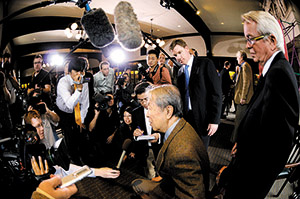Imperfect symmetry
Theoretician Yoichiro Nambu wins the Nobel Prize for work that shaped modern particle physics.
By Mary Ruth Yoe
Photography by Dan Dry
There is a certain symmetry in the numbers: this fall, the number of University of Chicago Nobel laureates rose to 82, in physics to 28.
Symmetry has long been a cornerstone of physics theory, but as Yoichiro Nambu of the Enrico Fermi Institute explained on October 7, “sometimes symmetry looks like it’s broken.” With an experienced teacher’s skill, he then offered a real-life example.
“When you have a large crowd of people, like here”—the Reynolds Club’s McCormick Tribune Lounge, filled with reporters, cameramen, colleagues, and well-wishers—“and they’re all facing toward me, not the other way around—there’s no physical reason they should all look the same way at the same time,” like all the ions on a magnet suddenly pointing the same way. “That’s symmetry breaking.”
There was, of course, a force drawing faces toward Nambu. The 87-year-old Harry Pratt Judson distinguished service professor emeritus had just won the 2008 Nobel in physics. Cited for “the discovery of the mechanism of spontaneous broken symmetry in subatomic physics,” Nambu received one-half of the $1.4 million prize. Makoto Kobayashi of the High Energy Accelerator Research Organization (KEK) in Tsukuba, Japan, and Toshihide Maskawa of Kyoto University, shared the other half for related research that predicts the existence of at least three families of quarks.
 Press forward: Nambu addresses the media the day his Nobel is announced.
Press forward: Nambu addresses the media the day his Nobel is announced. Asked to explain spontaneous symmetry breaking (SSB) in layman’s terms, Nambu offered this caveat: “It’s rather difficult because it’s a concept, not an application, something concrete.”
But it is a concept with solid applications “in superconductivity, in condensed matter, in magnetism,” physics Nobelist James Cronin, SM’53, PhD’55—who has known Nambu since the Japan-born theoretician arrived on campus in 1954—told the crowd at the press conference.
Nambu developed SSB in the early 1960s, puzzling over a violation of symmetry in superconductivity theory. It took him two years to figure out SSB’s role; then he quickly applied the concept to particle physics, where it has become, in Cronin’s words, “the cornerstone of the standard model of particle physics, which unites the strong interactions, the electromagnetic interactions, and the weak interactions all in a clear, understandable whole.”
In addition to his work on SSB, Nambu is widely recognized for his contributions to the color-gauge theory (an explanation of how the strong nuclear force governs the behavior of the quarks that make up protons and neutrons in atomic nuclei), and he is considered one of the founders of string theory. As Cronin declared, “It has been clear for so many years that of all the people who have won the Nobel Prize, there has been one missing, and that is Yoichiro Nambu.”
For his part, Nambu confessed that after 30 years of being touted as a possible Nobelist, “I must say, I was very surprised when I got the news.”
Nambu received his BS in 1942 from the University of Tokyo and was drafted into the Japanese military, working at a radar laboratory. After receiving his DSc from the University of Tokyo in 1952, he went to study with J. Robert Oppenheimer at the Institute for Advanced Study in Princeton. Two years later, rather than returning to a professorial position in Japan, Nambu said, he wanted to stay on in the States and “jumped at the opportunity to come here, with so many great names.” When he arrived, “I found it was much better than I had thought. So I decided to stay here.” And stay he did; 54 years later, he and his wife Chieko live a few blocks from campus; their son, John J. Nambu, AB’73, lives in New York City.
Nambu, who became a U.S. citizen in 1970, was elected to the National Academy of Sciences in 1971 and received the U.S. Medal of Science in 1982. His other honors include the J. Robert Oppenheimer Prize (1976), the Order of Culture from the government of Japan (1978), and the Wolf Prize in Physics (1994).
His current research centers on “one of the last unsolved problems of the Standard Model”: why different quarks have different masses. Theorists believe the answer is SSB–related, and it is a problem, Nambu said at the Nobel press conference, that “I hope to keep thinking about as long as I live.”
Return to top